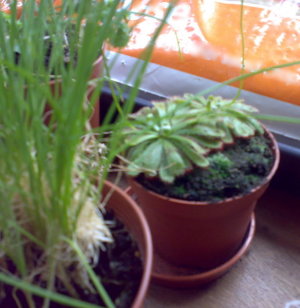My Food Growing and Gardening
Growing tomatoes (and other stuff)
Growing stuff, mostly edible stuff, mostly tomatoes
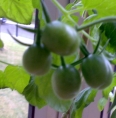 There is little as satisfying as eating food you have grown yourself. I will admit, my wife usually cooks with it, but I have all the pleasure of growing it. Sure, a couple of non-food plants make the list (like the carnivorous ones that keep away pests), but it is nearly all edible. Tomatoes are pretty easy to grow, although they will need a bit of care. No supermarket tomato compares with one straight off the vine which has never been chilled or stored, and is still naturally warm.
There is little as satisfying as eating food you have grown yourself. I will admit, my wife usually cooks with it, but I have all the pleasure of growing it. Sure, a couple of non-food plants make the list (like the carnivorous ones that keep away pests), but it is nearly all edible. Tomatoes are pretty easy to grow, although they will need a bit of care. No supermarket tomato compares with one straight off the vine which has never been chilled or stored, and is still naturally warm.
Contents

Me and My Plants
I grow stuff and build stuff. Generally I only want to grow stuff I can eat, and may “hack my plants”.
I built the boxes I used to grow indoor tomatoes from unwanted furniture. The soil mix was based on research and a little trial and error.
My Son, daughter, wife and I love eating tomatoes. Home grown ones are even sweeter!
Grow your own food and eat it!
It is really as simple as this. Find a good spot like a window sill, shed or garden (you lucky, lucky thing). Take some tomato seeds, squirt them into a dish, add soil and water, or take some onions or potatoes gone to seed. Then get a nice big growbag, and plant them. Sure, you could go all out and take a lot of care, or you can simply water them and watch them grow. Eat what you grow, and it is done!
You do not need to be an expert to grow food. in fact, although it requires a little commitment of time and willingness to learn on the job, it is really simple to get started. This kit has everything you will need for your first food plants, and can be done in a window sill. This kit gets the seeds going quickly with no dirt or mess. It is 100% natural and organic.
Where did it start?
When did I start growing stuff at all?
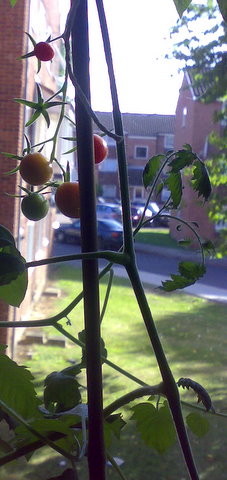
Well a few years back, we started buying the fresher herbs in supermarkets, and eventually got onto the potted herbs. In our old flat, the light was poor, so we mostly harvested them within a couple of weeks. After we bought a new flat, I decided to bring some life to it by stocking a large balcony window sill with many herbs. We started with a basil plant, which lasted for a year or so, as well as Rosemary and Thyme. I got more, and more interested and now have what is basically a jungle in the sill - with two varieties of tomatoes (some old and new), basil, rosemary, thyme, parsley, chives, a rubber plant and a carnivorous sundew plant .
I have enjoyed growing them, learned a lot from them. I have experimented with the plants, found easy ways to get seed and things that cannot be easily grown from seed (at least in an indoor household environment) like Apples.
I hope by sharing my experiences, others can have a go at growing their own food and plants, and also can share their growing tips with me too. Maybe tell me where I am going wrong, as well as appraise my experiments and take note of the failures. I will even throw in some mad ideas/inventions related to my growing of plants.
I will continue to place photos of my plants, the tomatoes and other bounties I get on this site. reading below you will find out about other tips, contraptions and things I have done. I have created HOWTOs for building your own for some of them and will expand with more.
My Plants
A close up of my Tomatoes flowering. Those flowers will become fruits. I am always delighted to see them.
One weeks cherry tomato harvest in 2008. These are from a couple of window sill plants. The smallest ones are by far the sweetest.
One weeks cherry tomato harvest in 2008. These are from a couple of window sill plants. The plants were producing this much every week right up until mid December.
A close up of my cherry tomatoes in 2008.
Tomato seedlings - good for gifts as there were too many to plant out in my patch. My propagator gave me more seedlings than I had room for.
A cherry tomato plant fruiting, with the bamboo supporting it.
A bamboo cane across the top added extra support, I now use willow trellises for this.
The sundew is a good pest control as flying things stick to its leaves and then get digested. The foreground has chives. Chives are very easy to grow and they also discourage pests. They go well in plenty of dishes.
More fruiting cherry tomato close ups.
Using the DIY propagator for tomatoes
I built a propagator, and used it for the tomatoes.

When I first started growing tomatoes, and the second time around, I figured that if they like a greenhouse, then I should build some sort of propagator to get the seeds on the go.
So I built one, and it is documented at HOWTO:Make a simple seed propagator.
It was successful, in fact perhaps a little too successful since I used (each time) a whole tomatoes set of seeds. I got 22 seedlings from one tomato with the last set!
I am finding out that Tomato seeds are vigorous, so not too many should be put into a propagator. considering it is a 6” dish, planting them around 1” apart should give more reasonable numbers than I ended up with last year. They have nearly 100% growth from seeds taken from supermarket fruit. However it is not all bad, they made for plenty of great gifts. Some got a bit leggy before they could be planted out, but most were fine.
Materials I usually use
Trying to keep it real and organic
I grow all my plants indoors as I do not yet have a garden. Since I would like to eat them, and they are in very small and limited eco-systems, I have to think very carefully about what I buy and use for them.
I use a screwdriver from a Christmas cracker as a dibber since it was little use for anything else, and saves having to buy a dibber. It works fairly well.
For tying heavier tomato plants to stakes, I use either hemp rope, or simple garden string.
Organic compost or potting compound
Since I will eat them, I only use organic compost for potting. This is normally also peat-free since peat is a natural resource which is declining currently. I look for compost with some fibre ballast to keep water in, and enough bulk for good drainage - this together means roots are neither dry nor saturated, and nutrients are not merely washed out after a few waterings. I find that B & Q in the UK stock a few general purpose composts, as well as bulb fibre and other things.
My current compost is the Miracle-gro organic peat free general purpose compost (which is not yet on Amazon). I am yet to try the compost disks currently stocked on Amazon. If you look around you can get organic growbags, which are handy for the more mature veg.
Using your own soil
You can also use your own garden or local soil, but you need to really think about this. It may not be the right mix or consistency, and may be too acidic or alkali for your plants. Also it will probably not have the right kind of water drainage and holding properties for a pot. You can remedy drainage issues with perlite or better still vermiculite, which holds water and stops nutrients being simply washed out.
Also it is likely the soil will have pests, bacteria and fungi, so you will need to sterilise it. For that, pour boiling water through it a couple of times to kill them off. Remember, a window sill does not have the natural controls to stop pests becoming too much of a problem!
Vermiculite can be used to aid drainage and water holding properties of soil or compost.
Plant food
I then like to use a plant food to top up and enhance the nutrients. It is again important, perhaps more so, that this is organic. I found that B & Q stock a few types of organic tomato food. This stuff is potent, and needs to be watered down, to the extend of one cap full going into a few litres. The great thing about this stuff is it can be used on all my other plants to, so I just mix it up in my watering can.
Dont forget a watering can
Plants can be watered with anything you have around, but a proper watering can with a spout makes sure the water can be delivered under foliage to a plant, where it is needed. A watering can may also be used to mix up the plant food, and give all the plants a good feed and watering together. Be sure to clean it between feedings though!
Stakes to hold plants up
I use bamboo for the tomato canes, and refuse to introduce plastic or metal canes which may leach unwanted stuff into the soil.
I use them with some twine to create a small truss for tomatoes to grow upon, as well as tying tomato plants to it so the fruit is supported. For larger groups of plans, expandable willow trellises look great, but when difficult to find, bamboo ones will do.
For smaller plants and seedlings, wooden barbecue skewers are just the job.
Bamboo Skewers
Some simple untreated wooden barbecue skewers are good for aerating soil when poked through, scraping off pests, and also as supports for very young tomato plants. Very handy indeed.
Expandable Bamboo Trellis
As you start to get larger or many plants, a trellis like this will really help, although this may also mean you need to start finding a larger space for them. Indoor plants this size can become a little unmanageable.
Plant pots
I mostly use plastic pots, but I have recently come across fibre and peat pots. Coir fibre has its own nutrients, and also retains a bit of moisture. When a plant has outgrown it, roots will come straight through, which has two advantages, firstly, you will know pretty soon that it is ready for planting out into a larger pot, and secondly you do not have to remove the pot to plant out.
I almost always use terracotta coloured pots as I find them aesthetically pleasing.
I also like the tiny little peat pots - These have the advantage of being able to be planted straight out into larger pots, and eventually growbags, without having to pull them out of their previous pot.
Make your own seed starting pots
It is surprisingly easy
There is more than one way to make your own plant pots for starting seeds, with similar benefits to using the peat or coir pots, without the expense.
The first is using newspaper, you can actually make it damp, and mould it into a pot shape. There are kits you can buy to mould it, and hold it into shape for day so it holds.
The other I got from another great lens - How to Reuse Toilet-paper Rolls, which is to use a toilet paper roll as a seed starting pot. You simply cut the roll in half, fill with soil, and place them close together in a tray. Try this video for some ideas How to start seeds using toilet paper rolls
Pest Control for your food plants
When growing anything, you are eventually going to encounter pests. Trust me - they’ve a way of getting to your plants, and learning methods of pest control is essential. It is so essential that it gets a page of its own. For any food growers, ignoring things that crawl on your plants may lead to a lot of disappointment.
Read on to find out what I did, and ways to do so that avoid spoiling food plants and keep them edible.
Organic Food Plant Pest and Parasite control
My pest control - a Sundew behind some chives.

Tomato plants as gifts
 Tomato seedlings, once potted and grown out a little, make superb gifts. People tend to feel something you have grown and cared for a lot more meaningful than some consumer plastic rubbish bought in a rush in a supermarket. They have the added bonus of being quite a frugal gift too.
Tomato seedlings, once potted and grown out a little, make superb gifts. People tend to feel something you have grown and cared for a lot more meaningful than some consumer plastic rubbish bought in a rush in a supermarket. They have the added bonus of being quite a frugal gift too.
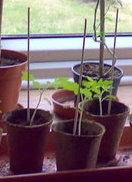 This also gives the opportunity of introducing yet another person to the idea of planting and growing their own food, although when given, plenty of advice should be on hand and given too.
This also gives the opportunity of introducing yet another person to the idea of planting and growing their own food, although when given, plenty of advice should be on hand and given too.
Even better is when these plants can be exchanged - you give someone a couple of tomato seedlings, they give you a few chilli, or strawberry seedlings. Home grown plants like this will be sturdier than supermarket growing plants because they will have been lovingly cared for and tended to.
I am not yet sure how easily strawberries would grow in a window sill.
A few gift plants sit reasonably well in the bottom of a gift bag, or one of the documentation bags that are given away at trade shows. They have a flat bottom, and make the plants look presentable. I have successfully delivered plants across London on tube trains and buses this way.
A few weeks on and the receiver will still be thinking about plants, and they will not be gathering dust in the back of a cupboard. Of course, you may need to give them some tips and advice to get them started.
Home grown tomatoes are awesome
I’ve a special place in my stomach for home grown tomatoes. I love the tiny ones and the really big fat ones too. I love growing my own when I’ve space for them too!
Organic Food Plant Pest and Parasite control
In this page are descriptions of common pests, parasites, infections, insects, fungi and diseases seen in food plants, along with organic and frugal ways to...
Flowering, Fruit and the tasty results
In a while, after growing tomatoes, they will begin to put out flowering trusses. The flowers are a very endearing and distinct yellow colour. They do not necessarily need bees to pollinate them because of the way they are arranged, however, they do need a little bit of a shake to self pollinate.
Given a short while, the flowers will either die, or the petals will drop, and a fruit will begin to form. The fruit forms green, grows in size (depending on variety), and uses sugars from photosynthesis to sweeten the tomatoes - they will ripen. Here you want to let the foliage grow larger so that there is plenty of green surface area. It is because of this reliance on sunlight, that the best fruit tends to be ripe at the end of the summer - around August in the UK.
If you are lucky, the plant will keep flowering and producing fruit for a while, although as things get colder it will slow down.
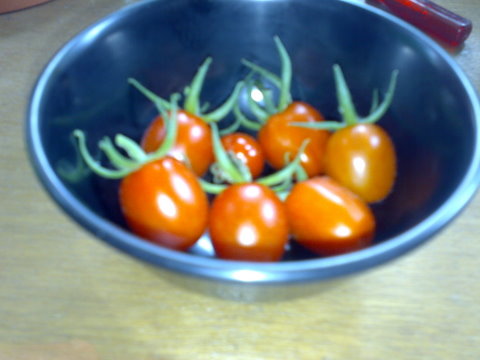 Tasty Ripe Cherry Tomatoes
State of my plants: October 2008
How are my plants doing a little later in the year?
Update: it is October in the UK, and my cherry tomatoes are still flowering wonderfully - producing about 5 or so ripe fruit a week. I have had to deal with them becoming a bit of a jungle when worked a week out of town, as they can put out tendrils really, really quick.
The new plants, which were seedlings are showing mixed results. It seems that giving them larger pots, gets immediate results, they soon get much taller. One or two have become too leggy so I have nipped off the growing buds at the top and caused them to put out lateral shoots below. These tall ones are now potted with 1.2 meter canes to give them some support, and one looks like it may put out its first truss of tomatoes. This new batch are the larger moneymaker variety, again started from supermarket tomato seed.
The smaller ones, are still in their smaller pots, although I have been repotting and planting them out, I have run off the space, and started giving tomato seedlings, along with advice to care to them, to my neighbours and friends. There are just too many of them, and they cannot possibly all survive in that small window balcony space.
Another neighbour opposite has bought some large tomato plants recently, so the display in my window may have had a positive affect. One of the neighbours will be letting their children look after the seedlings, they say the seedlings may not survive, but it will be a great experience for their kids to learn a little about growing things, and I consider education and getting kids to interact with plants or nature a worthy cause.
Because there are so many plants in my window balcony area, I actually have to layer, by layer, bring them down from the balcony area to tend to the ones behind them, ensuring they are properly watered, fed, that any dead or ill looking leaves are removed, that pests are under control, that there is no standing water in their drip dish and also giving a little shake to their flowers. Three older cherry tomato plants are in a growing bag together at the back, the outer two seem to be doing better than the one in the middle (perhaps a bit of unfriendly root competition?), but they are all still growing. Keeping these three from getting into a tangle with each other is increasingly difficult. Because they are heavy, I have strung together some of the bamboo to make a small structure to tie some heavier parts off on and tie parts of one plant away from the others.
The reason I shake flowers is to encourage them to pollinate, only gently mind, but it just hopefully increases the odds.
I have also been having a battle with fungus gnats which have gotten into my plant pots. Go see my plant pest control article to find out more about my battle.
{: style="margin-bottom: 5px"}
While surfing around, I have found a number of useful tidbits of info on growing all sorts of stuff, and about tomatoes. While collecting them in my browser bookmarks is a bit helpful, popping them on here means others can benefit and I can read up when online but away from that PC.- HOWTO: Self watering plant pot experiment
- I experimented with a simple, non powered, self watering plant pot system of my own. Read up to see how and get ideas for your own.
- How to Water and Feed Your Plants
- Knowing how to water and feed your plants, and when, requires a one-to-one relationship with each plant you own...
- HOWTO: Make a simple seed propagator
- When I first started growing tomatoes, and the second time around, I figured that if they like a greenhouse, then I should build some sort of propagator to get the seeds on the go.Buying a propagator seemed a little expensive, plus being able to build it with gear I had in the flat saved me a trip to the local DIY store...
- Growing Herbs Indoors
- A handy article I found early when starting to grow stuff I could eat in my home.
- GO GREEN: COMPOST
- Turning vegetable waste into nutrient rich soil through the process of composting is such a simple task that virtually anyone can participate...
- How to prune your tomato plants with pictures.
- Pictures and experienced advice from gardeners on how to prune both bush (determinate) and upright (indeterminate) tomato plants.
- The charm of chives by Gail Reynolds from the May/June, 2003 issue of Countryside & Small Stock Journal
- The charm of chives by Gail Reynolds from the May/June, 2003 issue of Countryside & Small Stock Journal
- Fruit Terminology (Part 4)
- A description of the structure of fleshy fruits, including the tomato. This website is a very useful resource in general on learning about fruits, the structure of them, how they grow and develop.
Understanding this will allow you to improve the growth of your own fruits and foods. - Garden Rant: Worm Composter Roundup
- Newbie worm composter here, trying a large homemade bin (shown here) but dreaming of something MUCH better. That's because this single-compartment system is waaay too inexact, too messy, too intimate! My friend uses one and LOVES dumping the entire contents...
- Cheap and Easy Worm Bin!
- How to build your own worm composter with a few tupperware/rubbermaid containers. All you need is worms. I think I may try this one out.
- Build a wooden worm compost bin
- This is details on building a composting worm bin with wood - more solid than the tupperware one, but with only one tier it is perhaps less sophisticated.

